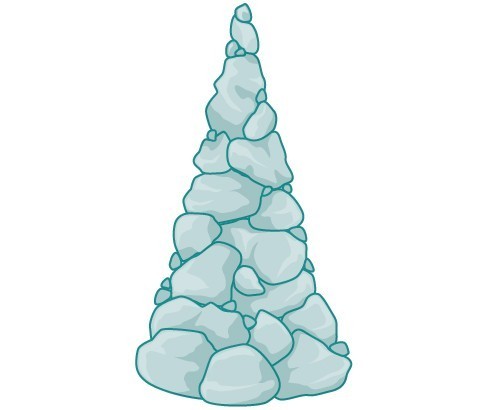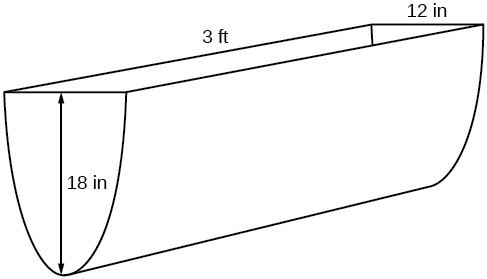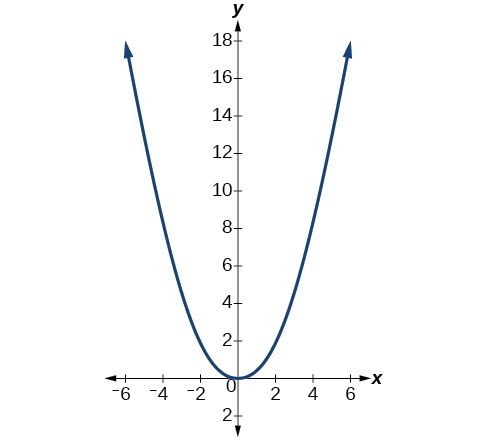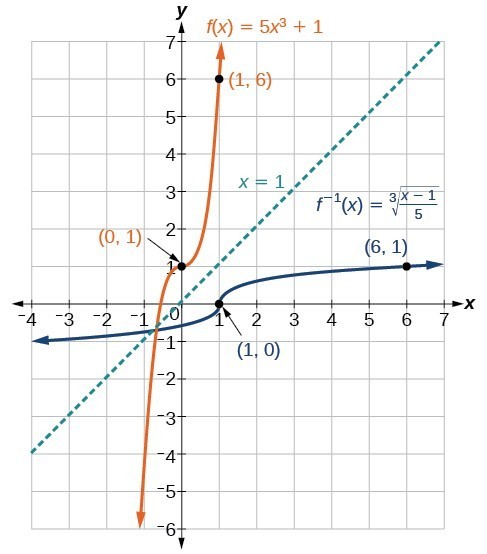Radical Functions
A mound of gravel is in the shape of a cone with the height equal to twice the radius. The volume is found using a formula from elementary geometry.
The volume is found using a formula from elementary geometry.
[latex]\begin{array}{l}V=\frac{1}{3}\pi {r}^{2}h\hfill \\ \text{ }=\frac{1}{3}\pi {r}^{2}\left(2r\right)\hfill \\ \text{ }=\frac{2}{3}\pi {r}^{3}\hfill \end{array}[/latex]
We have written the volume V in terms of the radius r. However, in some cases, we may start out with the volume and want to find the radius. For example: A customer purchases 100 cubic feet of gravel to construct a cone shape mound with a height twice the radius. What are the radius and height of the new cone? To answer this question, we use the formula[latex]r=\sqrt[3]{\frac{3V}{2\pi }}[/latex]
This function is the inverse of the formula for V in terms of r. In this section, we will explore the inverses of polynomial and rational functions and in particular the radical functions we encounter in the process.Radicals as Inverse Polynomial Functions
Two functions f and g are inverse functions if for every coordinate pair in f, (a, b), there exists a corresponding coordinate pair in the inverse function, g, (b, a). In other words, the coordinate pairs of the inverse functions have the input and output interchanged. For a function to have an inverse function the function to create a new function that is one-to-one and would have an inverse function. For example, suppose a water runoff collector is built in the shape of a parabolic trough as shown below. We can use the information in the figure to find the surface area of the water in the trough as a function of the depth of the water. Because it will be helpful to have an equation for the parabolic cross-sectional shape, we will impose a coordinate system at the cross section, with x measured horizontally and y measured vertically, with the origin at the vertex of the parabola.
Because it will be helpful to have an equation for the parabolic cross-sectional shape, we will impose a coordinate system at the cross section, with x measured horizontally and y measured vertically, with the origin at the vertex of the parabola.
 From this we find an equation for the parabolic shape. We placed the origin at the vertex of the parabola, so we know the equation will have form [latex]y\left(x\right)=a{x}^{2}[/latex]. Our equation will need to pass through the point (6, 18), from which we can solve for the stretch factor a.
From this we find an equation for the parabolic shape. We placed the origin at the vertex of the parabola, so we know the equation will have form [latex]y\left(x\right)=a{x}^{2}[/latex]. Our equation will need to pass through the point (6, 18), from which we can solve for the stretch factor a.
[latex]\begin{array}{l} 18=a{6}^{2}\hfill \\ a=\frac{18}{36}\hfill \\ \text{ }=\frac{1}{2}\hfill \end{array}[/latex]
Our parabolic cross section has the equation[latex]y\left(x\right)=\frac{1}{2}{x}^{2}[/latex]
We are interested in the surface area of the water, so we must determine the width at the top of the water as a function of the water depth. For any depth y the width will be given by 2x, so we need to solve the equation above for x and find the inverse function. However, notice that the original function is not one-to-one, and indeed, given any output there are two inputs that produce the same output, one positive and one negative. To find an inverse, we can restrict our original function to a limited domain on which it is one-to-one. In this case, it makes sense to restrict ourselves to positive x values. On this domain, we can find an inverse by solving for the input variable:[latex]\begin{array}{l}y=\frac{1}{2}{x}^{2}\hfill \\ 2y={x}^{2}\hfill \\ \text{ }x=\pm \sqrt{2y}\hfill \end{array}[/latex]
This is not a function as written. We are limiting ourselves to positive x values, so we eliminate the negative solution, giving us the inverse function we’re looking for.[latex]y=\frac{{x}^{2}}{2},\text{ }x>0[/latex]
Because x is the distance from the center of the parabola to either side, the entire width of the water at the top will be 2x. The trough is 3 feet (36 inches) long, so the surface area will then be:[latex]\begin{array}{l}\text{Area} & =l\cdot w\hfill \\ \text{ } & =36\cdot 2x\hfill \\ \text{ } & =72x\hfill \\ \text{ } & =72\sqrt{2y}\hfill \end{array}[/latex]
This example illustrates two important points:- When finding the inverse of a quadratic, we have to limit ourselves to a domain on which the function is one-to-one.
- The inverse of a quadratic function is a square root function. Both are toolkit functions and different types of power functions.
[latex]{f}^{-1}\left(f\left(x\right)\right)=x,\text{for all }x\text{ in the domain of }f[/latex]
and[latex]f\left({f}^{-1}\left(x\right)\right)=x,\text{for all }x\text{ in the domain of }{f}^{-1}[/latex]
A General Note: Verifying Two Functions Are Inverses of One Another
Two functions, f and g, are inverses of one another if for all x in the domain of f and g. [latex-display]g\left(f\left(x\right)\right)=f\left(g\left(x\right)\right)=x[/latex-display]How To: Given a polynomial function, find the inverse of the function by restricting the domain in such a way that the new function is one-to-one.
- Replace [latex]f\left(x\right)[/latex] with y.
- Interchange x and y.
- Solve for y, and rename the function [latex]{f}^{-1}\left(x\right)[/latex].
Example: Verifying Inverse Functions
Show that [latex]f\left(x\right)=\frac{1}{x+1}[/latex] and [latex]{f}^{-1}\left(x\right)=\frac{1}{x}-1[/latex] are inverses, for [latex]x\ne 0,-1[/latex] .Answer: We must show that [latex]{f}^{-1}\left(f\left(x\right)\right)=x[/latex] and [latex]f\left({f}^{-1}\left(x\right)\right)=x[/latex].
[latex]\begin{array}{l}{f}^{-1}\left(f\left(x\right)\right)={f}^{-1}\left(\frac{1}{x+1}\right)\hfill \\ \text{ }=\frac{1}{\frac{1}{x+1}}-1\hfill \\ \text{ }=\left(x+1\right)-1\hfill \\ \text{ }=x\hfill \\ f\left({f}^{-1}\left(x\right)\right)=f\left(\frac{1}{x}-1\right)\hfill \\ \text{ }=\frac{1}{\left(\frac{1}{x}-1\right)+1}\hfill \\ \text{ }=\frac{1}{\frac{1}{x}}\hfill \\ \text{ }=x\hfill \end{array}[/latex]
Therefore, [latex]f\left(x\right)=\frac{1}{x+1}[/latex] and [latex]{f}^{-1}\left(x\right)=\frac{1}{x}-1[/latex] are inverses.Try It
Show that [latex]f\left(x\right)=\frac{x+5}{3}[/latex] and [latex]{f}^{-1}\left(x\right)=3x - 5[/latex] are inverses.Answer: [latex]{f}^{-1}\left(f\left(x\right)\right)={f}^{-1}\left(\frac{x+5}{3}\right)=3\left(\frac{x+5}{3}\right)-5=\left(x - 5\right)+5=x[/latex] and [latex]f\left({f}^{-1}\left(x\right)\right)=f\left(3x - 5\right)=\frac{\left(3x - 5\right)+5}{3}=\frac{3x}{3}=x[/latex]
Example: Finding the Inverse of a Cubic Function
Find the inverse of the function [latex]f\left(x\right)=5{x}^{3}+1[/latex].Answer: This is a transformation of the basic cubic toolkit function, and based on our knowledge of that function, we know it is one-to-one. Solving for the inverse by solving for x.
[latex]\begin{array}{l}\text{ }y=5{x}^{3}+1\hfill \\ \text{ }x=5{y}^{3}+1\hfill \\ \text{ }x - 1=5{y}^{3}\hfill \\ \text{ }\frac{x - 1}{5}={y}^{3}\hfill \\ {f}^{-1}\left(x\right)=\sqrt[3]{\frac{x - 1}{5}}\hfill \end{array}[/latex]
Analysis of the Solution
Look at the graph of f and [latex]{f}^{-1}[/latex]. Notice that the two graphs are symmetrical about the line [latex]y=x[/latex]. This is always the case when graphing a function and its inverse function. Also, since the method involved interchanging x and y, notice corresponding points. If [latex]\left(a,b\right)[/latex] is on the graph of f, then [latex]\left(b,a\right)[/latex] is on the graph of [latex]{f}^{-1}[/latex]. Since [latex]\left(0,1\right)[/latex] is on the graph of f, then [latex]\left(1,0\right)[/latex] is on the graph of [latex]{f}^{-1}[/latex]. Similarly, since [latex]\left(1,6\right)[/latex] is on the graph of f, then [latex]\left(6,1\right)[/latex] is on the graph of [latex]{f}^{-1}[/latex].
Try It
Find the inverse function of [latex]f\left(x\right)=\sqrt[3]{x+4}[/latex].Answer: [latex]{f}^{-1}\left(x\right)={x}^{3}-4[/latex]
Domains of Radical Functions
So far, we have been able to find the inverse functions of cubic functions without having to restrict their domains. However, as we know, not all cubic polynomials are one-to-one. Some functions that are not one-to-one may have their domain restricted so that they are one-to-one, but only over that domain. The function over the restricted domain would then have an inverse function. Since quadratic functions are not one-to-one, we must restrict their domain in order to find their inverses.A General Note: Restricting the Domain
If a function is not one-to-one, it cannot have an inverse. If we restrict the domain of the function so that it becomes one-to-one, thus creating a new function, this new function will have an inverse.How To: Given a polynomial function, restrict the domain of a function that is not one-to-one and then find the inverse.
- Restrict the domain by determining a domain on which the original function is one-to-one.
- Replace f(x) with y.
- Interchange x and y.
- Solve for y, and rename the function or pair of function [latex]{f}^{-1}\left(x\right)[/latex].
- Revise the formula for [latex]{f}^{-1}\left(x\right)[/latex] by ensuring that the outputs of the inverse function correspond to the restricted domain of the original function.
Example: Restricting the Domain to Find the Inverse of a Polynomial Function
Find the inverse function of f:- [latex]f\left(x\right)={\left(x - 4\right)}^{2}, x\ge 4[/latex]
- [latex]f\left(x\right)={\left(x - 4\right)}^{2}, x\le 4[/latex]
Answer:
The original function [latex]f\left(x\right)={\left(x - 4\right)}^{2}[/latex] is not one-to-one, but the function is restricted to a domain of [latex]x\ge 4[/latex] or [latex]x\le 4[/latex] on which it is one-to-one.
 To find the inverse, start by replacing [latex]f\left(x\right)[/latex] with the simple variable y.
To find the inverse, start by replacing [latex]f\left(x\right)[/latex] with the simple variable y.
[latex]\begin{array}{l}y={\left(x - 4\right)}^{2}\hfill & \text{Interchange } x \text{ and }y.\hfill \\ x={\left(y - 4\right)}^{2}\hfill & \text{Take the square root}.\hfill \\ \pm \sqrt{x}=y - 4 \hfill & \text{Add } 4 \text{ to both sides}.\hfill \\ 4\pm \sqrt{x}=y\hfill & \hfill \end{array}[/latex]
This is not a function as written. We need to examine the restrictions on the domain of the original function to determine the inverse. Since we reversed the roles of x and y for the original f(x), we looked at the domain: the values x could assume. When we reversed the roles of x and y, this gave us the values y could assume. For this function, [latex]x\ge 4[/latex], so for the inverse, we should have [latex]y\ge 4[/latex], which is what our inverse function gives.- The domain of the original function was restricted to [latex]x\ge 4[/latex], so the outputs of the inverse need to be the same, [latex]f\left(x\right)\ge 4[/latex], and we must use the + case: [latex]{f}^{-1}\left(x\right)=4+\sqrt{x}[/latex]
- The domain of the original function was restricted to [latex]x\le 4[/latex], so the outputs of the inverse need to be the same, [latex]f\left(x\right)\le 4[/latex], and we must use the – case: [latex]{f}^{-1}\left(x\right)=4-\sqrt{x}[/latex]
Analysis of the Solution
On the graphs below, we see the original function graphed on the same set of axes as its inverse function. Notice that together the graphs show symmetry about the line [latex]y=x[/latex]. The coordinate pair [latex]\left(4, 0\right)[/latex] is on the graph of f and the coordinate pair [latex]\left(0, 4\right)[/latex] is on the graph of [latex]{f}^{-1}[/latex]. For any coordinate pair, if (a, b) is on the graph of f, then (b, a) is on the graph of [latex]{f}^{-1}[/latex]. Finally, observe that the graph of f intersects the graph of [latex]{f}^{-1}[/latex] on the line y = x. Points of intersection for the graphs of f and [latex]{f}^{-1}[/latex] will always lie on the line y = x.
Example: Finding the Inverse of a Quadratic Function When the Restriction Is Not Specified
Restrict the domain and then find the inverse of[latex]f\left(x\right)={\left(x - 2\right)}^{2}-3[/latex].
Answer: We can see this is a parabola with vertex at [latex]\left(2, -3\right)[/latex] that opens upward. Because the graph will be decreasing on one side of the vertex and increasing on the other side, we can restrict this function to a domain on which it will be one-to-one by limiting the domain to [latex]x\ge 2[/latex]. To find the inverse, we will use the vertex form of the quadratic. We start by replacing f(x) with a simple variable, y, then solve for x.
[latex]\begin{array}{l}y={\left(x - 2\right)}^{2}-3\hfill & \text{Interchange } x \text{ and } y.\hfill \\ x={\left(y - 2\right)}^{2}-3\hfill & \text{Add 3 to both sides}.\hfill \\ x+3={\left(y - 2\right)}^{2}\hfill & \text{Take the square root}.\hfill \\ \pm \sqrt{x+3}=y - 2\hfill & \text{Add 2 to both sides}.\hfill \\ 2\pm \sqrt{x+3}=y\hfill & \text{Rename the function}.\hfill \\ {f}^{-1}\left(x\right)=2\pm \sqrt{x+3}\hfill & \hfill \end{array}[/latex]
Now we need to determine which case to use. Because we restricted our original function to a domain of [latex]x\ge 2[/latex], the outputs of the inverse should be the same, telling us to utilize the + case[latex]{f}^{-1}\left(x\right)=2+\sqrt{x+3}[/latex]
If the quadratic had not been given in vertex form, rewriting it into vertex form would be the first step. This way we may easily observe the coordinates of the vertex to help us restrict the domain.Analysis of the Solution
Notice that we arbitrarily decided to restrict the domain on [latex]x\ge 2[/latex]. We could just have easily opted to restrict the domain on [latex]x\le 2[/latex], in which case [latex]{f}^{-1}\left(x\right)=2-\sqrt{x+3}[/latex]. Observe the original function graphed on the same set of axes as its inverse function in the graph below. Notice that both graphs show symmetry about the line y = x. The coordinate pair [latex]\left(2,\text{ }-3\right)[/latex] is on the graph of f and the coordinate pair [latex]\left(-3,\text{ }2\right)[/latex] is on the graph of [latex]{f}^{-1}[/latex]. Observe from the graph of both functions on the same set of axes that[latex]\text{domain of }f=\text{range of } {f}^{-1}=\left[2,\infty \right)[/latex]
and[latex]\text{domain of }{f}^{-1}=\text{range of } f=\left[-3,\infty \right)[/latex]
Finally, observe that the graph of f intersects the graph of [latex]{f}^{-1}[/latex] along the line y = x.
Try It
Find the inverse of the function [latex]f\left(x\right)={x}^{2}+1[/latex], on the domain [latex]x\ge 0[/latex].Answer: [latex]{f}^{-1}\left(x\right)=\sqrt{x - 1}[/latex]
Solving Applications of Radical Functions
Notice that the functions from previous examples were all polynomials, and their inverses were radical functions. If we want to find the inverse of a radical function, we will need to restrict the domain of the answer because the range of the original function is limited.How To: Given a radical function, find the inverse.
- Determine the range of the original function.
- Replace f(x) with y, then solve for x.
- If necessary, restrict the domain of the inverse function to the range of the original function.
Example: Finding the Inverse of a Radical Function
Restrict the domain and then find the inverse of the function [latex]f\left(x\right)=\sqrt{x - 4}[/latex].Answer: Note that the original function has range [latex]f\left(x\right)\ge 0[/latex]. Replace [latex]f\left(x\right)[/latex] with y, then solve for x.
[latex]\begin{array}{l}\hfill y& =\sqrt{x - 4}& \text{Replace}f\left(x\right)\text{with }y.\\ \hfill x& =\sqrt{y - 4}& \text{Interchange }x\text{ and }y.\hfill \\ \hfill x& =\sqrt{y - 4}& \text{Square each side}.\hfill \\ \hfill {x}^{2}& =y - 4& \text{Add 4}.\hfill \\ \hfill {x}^{2}+4& =y& \text{Rename the function }{f}^{-1}\left(x\right).\hfill \\ \hfill {f}^{-1}\left(x\right)& ={x}^{2}+4& \end{array}[/latex]
Recall that the domain of this function must be limited to the range of the original function.[latex]{f}^{-1}\left(x\right)={x}^{2}+4,x\ge 0[/latex]
Analysis of the Solution
Notice in the graph below that the inverse is a reflection of the original function over the line y = x. Because the original function has only positive outputs, the inverse function has only positive inputs.
Try It
Restrict the domain and then find the inverse of the function [latex]f\left(x\right)=\sqrt{2x+3}[/latex].Answer: [latex]{f}^{-1}\left(x\right)=\frac{{x}^{2}-3}{2},x\ge 0[/latex]
Solving Applications of Radical Functions
Radical functions are common in physical models, as we saw in the section opener. We now have enough tools to be able to solve the problem posed at the start of the section.Example: Solving an Application with a Cubic Function
A mound of gravel is in the shape of a cone with the height equal to twice the radius. The volume of the cone in terms of the radius is given by[latex]V=\frac{2}{3}\pi {r}^{3}[/latex]
Find the inverse of the function [latex]V=\frac{2}{3}\pi {r}^{3}[/latex] that determines the volume V of a cone and is a function of the radius r. Then use the inverse function to calculate the radius of such a mound of gravel measuring 100 cubic feet. Use [latex]\pi =3.14[/latex].Answer: Start with the given function for V. Notice that the meaningful domain for the function is [latex]r\ge 0[/latex] since negative radii would not make sense in this context. Also note the range of the function (hence, the domain of the inverse function) is [latex]V\ge 0[/latex]. Solve for r in terms of V, using the method outlined previously.
[latex]\begin{array}{l} V=\frac{2}{3}\pi {r}^{3}\hfill & \hfill \\ {r}^{3}=\frac{3V}{2\pi }\hfill & \text{Solve for }{r}^{3}.\hfill \\ r=\sqrt[3]{\frac{3V}{2\pi }}\hfill & \text{Solve for }r.\hfill \end{array}[/latex]
This is the result stated in the section opener. Now evaluate this for V = 100 and [latex]\pi =3.14[/latex].[latex]\begin{array}{l}r & =\sqrt[3]{\frac{3V}{2\pi }} \\\text{ } & =\sqrt[3]{\frac{3\cdot 100}{2\cdot 3.14}}\hfill \\\text{ } & \approx \sqrt[3]{47.7707}\hfill \\ \text{ } & \approx 3.63\hfill \end{array}[/latex]
Therefore, the radius is about 3.63 ft.Determining the Domain of a Radical Function Composed with Other Functions
When radical functions are composed with other functions, determining domain can become more complicated.Example: Finding the Domain of a Radical Function Composed with a Rational Function
Find the domain of the function [latex]f\left(x\right)=\sqrt{\frac{\left(x+2\right)\left(x - 3\right)}{\left(x - 1\right)}}[/latex].Answer:
Because a square root is only defined when the quantity under the radical is non-negative, we need to determine where [latex]\frac{\left(x+2\right)\left(x - 3\right)}{\left(x - 1\right)}\ge 0[/latex]. The output of a rational function can change signs (change from positive to negative or vice versa) at x-intercepts and at vertical asymptotes. For this equation, the graph could change signs at x = –2, 1, and 3.
To determine the intervals on which the rational expression is positive, we could test some values in the expression or sketch a graph. While both approaches work equally well, for this example we will use a graph.
 This function has two x-intercepts, both of which exhibit linear behavior near the x-intercepts. There is one vertical asymptote, corresponding to a linear factor; this behavior is similar to the basic reciprocal toolkit function, and there is no horizontal asymptote because the degree of the numerator is larger than the degree of the denominator. There is a y-intercept at (0, 6).
From the y-intercept and x-intercept at [latex]x=–2[/latex], we can sketch the left side of the graph. From the behavior at the asymptote, we can sketch the right side of the graph.
From the graph, we can now tell on which intervals the outputs will be non-negative, so that we can be sure that the original function f(x) will be defined. f(x) has domain [latex]-2\le x<1\text{or}x\ge 3[/latex], or in interval notation, [latex]\left[-2,1\right)\cup \left[3,\infty \right)[/latex].
This function has two x-intercepts, both of which exhibit linear behavior near the x-intercepts. There is one vertical asymptote, corresponding to a linear factor; this behavior is similar to the basic reciprocal toolkit function, and there is no horizontal asymptote because the degree of the numerator is larger than the degree of the denominator. There is a y-intercept at (0, 6).
From the y-intercept and x-intercept at [latex]x=–2[/latex], we can sketch the left side of the graph. From the behavior at the asymptote, we can sketch the right side of the graph.
From the graph, we can now tell on which intervals the outputs will be non-negative, so that we can be sure that the original function f(x) will be defined. f(x) has domain [latex]-2\le x<1\text{or}x\ge 3[/latex], or in interval notation, [latex]\left[-2,1\right)\cup \left[3,\infty \right)[/latex].
Finding Inverses of Rational Functions
As with finding inverses of quadratic functions, it is sometimes desirable to find the inverse of a rational function, particularly of rational functions that are the ratio of linear functions, such as in concentration applications.Example: Finding the Inverse of a Rational Function
The function [latex]C=\frac{20+0.4n}{100+n}[/latex] represents the concentration C of an acid solution after n mL of 40% solution has been added to 100 mL of a 20% solution. First, find the inverse of the function; that is, find an expression for n in terms of C. Then use your result to determine how much of the 40% solution should be added so that the final mixture is a 35% solution.Answer:
We first want the inverse of the function. We will solve for n in terms of C. [latex]\begin{array}{l}C=\frac{20+0.4n}{100+n}\\ C\left(100+n\right)=20+0.4n\\ 100C+Cn=20+0.4n\\ 100C - 20=0.4n-Cn\\ 100C - 20=\left(0.4-C\right)n\\ n=\frac{100C - 20}{0.4-C}\end{array}[/latex]
Now evaluate this function for C=0.35 (35%).[latex]\begin{array}{l}n=\frac{100\left(0.35\right)-20}{0.4 - 0.35}\\ =\frac{15}{0.05}\\ =300\end{array}[/latex]
We can conclude that 300 mL of the 40% solution should be added.Try It
Find the inverse of the function [latex]f\left(x\right)=\frac{x+3}{x - 2}[/latex].Answer: [latex]{f}^{-1}\left(x\right)=\frac{2x+3}{x - 1}\\[/latex]
Key Concepts
- The inverse of a quadratic function is a square root function.
- If [latex]{f}^{-1}[/latex] is the inverse of a function f, then f is the inverse of the function [latex]{f}^{-1}[/latex].
- While it is not possible to find an inverse of most polynomial functions, some basic polynomials are invertible.
- To find the inverse of certain functions, we must restrict the function to a domain on which it will be one-to-one.
- When finding the inverse of a radical function, we need a restriction on the domain of the answer.
- Inverse and radical and functions can be used to solve application problems.
Glossary
- invertible function
- any function that has an inverse function
Licenses & Attributions
CC licensed content, Original
- Revision and Adaptation. Provided by: Lumen Learning License: CC BY: Attribution.
CC licensed content, Shared previously
- Precalculus. Provided by: OpenStax Authored by: Jay Abramson, et al.. Located at: https://openstax.org/books/precalculus/pages/1-introduction-to-functions. License: CC BY: Attribution. License terms: Download For Free at : http://cnx.org/contents/[email protected]..
- College Algebra. Provided by: OpenStax Authored by: Abramson, Jay et al.. License: CC BY: Attribution. License terms: Download for free at http://cnx.org/contents/[email protected].
- Question ID 15856. Authored by: James Sousa. License: CC BY: Attribution. License terms: IMathAS Community License CC-BY + GPL.
- Question ID 119349, 129081. Authored by: Day, Alyson. License: CC BY: Attribution. License terms: IMathAS Community License CC-BY + GPL.
- Question ID 3333. Authored by: David Lippman. License: CC BY: Attribution. License terms: IMathAS Community License CC-BY + GPL.
- Ex: Restrict the Domain to Make a Function 1 to 1, Then Find the Inverse . Authored by: James Sousa (Mathispower4u.com) for Lumen Learning. License: CC BY: Attribution.
- Ex: Find the Inverse of a Rational Function . Authored by: James Sousa (Mathispower4u.com) for Lumen Learning. License: CC BY: Attribution.

